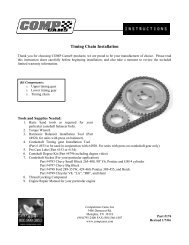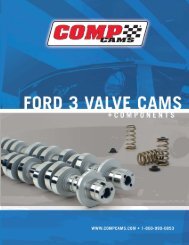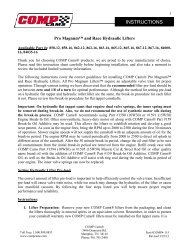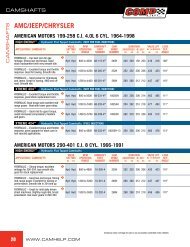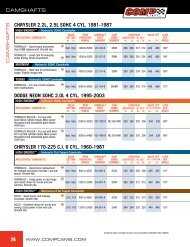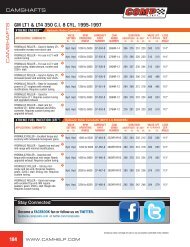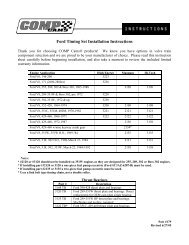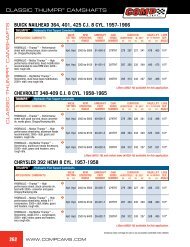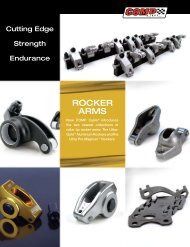You also want an ePaper? Increase the reach of your titles
YUMPU automatically turns print PDFs into web optimized ePapers that Google loves.
HOW TO ORDER<br />
2<br />
HOW TO ORDER<br />
<strong>COMP</strong> <strong>Cam</strong>s ® leads the industry in camshaft lobe offerings.<br />
With thousands of active lobes in the <strong>COMP</strong> library, the<br />
combinations are infinite for any given engine. That means<br />
that you can have a cam ground to your specific needs,<br />
and you have the broadest selection of lobes available anywhere.<br />
Choosing a cam for your specific application is a four-step<br />
process:<br />
1. Select a core<br />
2. Select the lobes<br />
3. Select a lobe separation angle<br />
4. Determine the part number and grind number, and<br />
order the cam<br />
<strong>Cam</strong>shaft lobes are broken into families, with each family<br />
having been developed to fit the performance requirements<br />
for certain applications. So, it is in that context that<br />
lobe selection should begin.<br />
1. Selecting a Core<br />
Within the parameter of core applications, we have<br />
fifteen cores that cover many engine applications. They are<br />
designated as follows:<br />
-0 Steel Billet Round <strong>Lobe</strong><br />
-5 Flat Tappet (Either Hydraulic or Solid Lifter)<br />
-5RR Reverse Rotation Flat Tappet<br />
-7 Special Flat Tappet<br />
-8 Street Roller (Either Hydraulic or Solid Roller)<br />
Special Material – Bronze Distributor Gear<br />
Not Required on Most Applications<br />
-9 Steel Billet Roller<br />
-9L OHC Roller Left<br />
-9R OHC Roller Right<br />
-9W Welded Steel Billet Flat Tappet<br />
-10 Steel Billet Roller<br />
-11 Steel Billet Roller<br />
-12 Steel Billet Roller<br />
-14 4/7 Swap Steel Billet Roller<br />
-16 Steel Flat Tappet<br />
-47 4/7 Swap Steel Flat Tappet<br />
Special Note: The -0 core is a round lobe core that is not<br />
heat-treated. These cores must be roughed and then heattreated<br />
before finished lobe grinding takes place.<br />
The complete core list follows on pages 5-7. The list is separated<br />
into the different cam core types. The part number<br />
in front of each core is used in ordering a custom ground<br />
cam for a particular engine type. It consists of a two-digit<br />
prefix designating the engine type, followed by a dash (-)<br />
and three consecutive zeros. The zeros indicate a custom<br />
ground cam. Next are a dash and number from the core<br />
designations previously listed.<br />
Example:<br />
Engine Prefix Part Number Core Type<br />
12- 000 -9<br />
The number 12- indicates Small Block Chevy (found on the<br />
core listing on pages 5-7).<br />
The number 000 indicates a custom grind.<br />
The -9 indicates steel billet roller core.<br />
2. Selecting <strong>Lobe</strong>s<br />
The lobes are listed on pages 8-61 and represent the<br />
most current library of lobes offered by <strong>COMP</strong> <strong>Cam</strong>s ® .<br />
They are arranged in groups, each of which is unique in<br />
its application. Along with each group is a description of<br />
each type, which is intended to help clarify each family<br />
of lobes so that you may accurately select lobes for<br />
your application.<br />
Some lobes specifically designated to be intake or exhaust<br />
lobes do not necessarily have to be run on the valve for<br />
which they were designed. If an exhaust lobe has the<br />
desired spec for intake (or vise versa) they may be used<br />
in that manner.<br />
Keep in mind while viewing the listings that certain flat tappet<br />
lobes are designed to be used only with correct<br />
diameter lifters.<br />
3. Choosing <strong>Lobe</strong> Separation Angle<br />
<strong>Lobe</strong> separation angles (the angle in cam degrees<br />
between the intake and exhaust lobe are also referred to<br />
as “lobe centers”) are very engine combination dependent.<br />
In general, a tighter separation (ex. 104°-106°) results in<br />
a “peakier” torque curve more suited to stick-shift cars<br />
with multiple gear ratios to change between. Wider lobe<br />
separation (ex. 110°-112°) results in a broader, flatter<br />
torque curve that is more suited to automatic transmission<br />
cars with fewer gears from which to choose.<br />
Therefore, engines have to be more powerful over a<br />
broader rpm range. Also, as lobes get larger at .050”<br />
duration (275° and up), it is necessary to begin widening<br />
separation angles to lessen the amount of overlap that<br />
accumulates from the larger lobes.<br />
One final note about lobe separation angles - the cam<br />
cores that are available for each application are designed<br />
for nominal, standard lobe separation angles. Straying<br />
from this nominal angle too far in one direction or another<br />
can result in the heat-treated surface of the core being<br />
ground through to the soft material underneath. Soft<br />
lobes will fail in an engine if allowed to run for very long.<br />
Whether or not the heat-treated surface is ground<br />
through also is obviously dependent on the lobe being<br />
ground on the core.<br />
The bottom line is that not all grinds can go on every core<br />
that is available. More popular engines, like the Small<br />
Block Chevy, have a variety of cores available with varying<br />
lobe separation angles that can accommodate almost any<br />
grind. Less popular applications, like the Flathead Ford<br />
V8, only have one core available. Therefore, they are<br />
somewhat limited in terms of what grind will fit on the single<br />
existing core.<br />
4. Determining a Part Number and<br />
Grind Number and Ordering<br />
With the part number determined in the core selection<br />
process, the grind number is the final step prior to ordering<br />
the cam. This process is simple and is accomplished<br />
by picking up the “lobe number” that appears in the left<br />
column of the lobe selection chart.<br />
The intake lobe will be first and the exhaust lobe will be<br />
second, followed by the lobe separation angle.<br />
1 . 8 0 0 . 9 9 9 . 0 8 5 3



